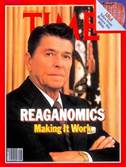Reaganomics vs. Obamanomics – Vastly Different Results
Thursday, March 27th, 2014 @ 8:51PM
Between the Lines
by Gary D. Halbert
The most interesting article I read this week came from economist Vance Ginn at The Texas Public Policy Foundation, a non-profit free-market research institute here in Austin, TX. He compares President Reagan’s economic policies with President Obama’s. The results are simply staggering! I have reprinted the entire article for you below.
QUOTE:
Reaganomics vs. Obamanomics: Two Wholly Different Outcomes
Despite adding almost a trillion dollars to our national debt and failing to keep the unemployment rate at or below 8% as advertised, liberals consider President Obama’s signature stimulus package — the American Recovery and Reinvestment Act — a success, in part because of the number of jobs it “saved.”
Beyond the obvious failings of the president’s plan, now more than five years old, the approach is illustrative of how presidents sometimes try to stabilize an economy using fiscal policy.
But there is a right way and a wrong way.
Sen. Ted Cruz recently remarked on two very different fiscal policy outcomes:
“Reaganomics means you start a business in your garage; Obamanomics means you move into your parent’s garage.”
Obama’s prescription for the last recession was to reinvigorate the economy by passing the ARRA and other policies over the next four years. These included ObamaCare to regulate the health care market, Dodd-Frank to regulate banks, Cash for Clunkers and extending unemployment benefits that collectively increased economic uncertainty and reduced incentives to hire and work.
 The passage of these historically large spending measures, plus lower tax revenues from a sluggish economy, led to record federal budget deficits that exceeded $1 trillion in fiscal years 2009 to 2012 and have thus far added almost $6 trillion to our national debt after fiscal year 2013.
The passage of these historically large spending measures, plus lower tax revenues from a sluggish economy, led to record federal budget deficits that exceeded $1 trillion in fiscal years 2009 to 2012 and have thus far added almost $6 trillion to our national debt after fiscal year 2013.
December 2013 marked the recovery’s 54th month, but stories of individuals moving into their parents’ garage are common because they can’t find work or are underemployed. Obama’s big-government policy prescriptions have left the labor market feeling sick.
The results are vastly different from the limited-government prescriptions offered by President Reagan in the 1980s.
Reagan also entered his first term with a sluggish economy that had back-to-back recessions within a year of each other. The latter, from July 1981 to November 1982, was a relatively severe recession with the unemployment rate reaching a high of 10.8%.
Contrary to President Obama’s prescription of more government spending and regulation, President Reagan diagnosed government as the problem and prescribed a plan of lowering tax rates and reducing regulations to free firms and workers from disincentives to invest and work.
This limited-government prescription led to a 92-month expansion — one of the longest on record — and helped increase the percentage of the working population from 57% to 63%.
A substantially different policy approach provided vastly different results.
To compare the employment growth between the two recoveries, consider the current recovery’s 54-month period through December 2013 with the same recovery length after the 1981-82 recession.
After adjusting for differences in the population in each period using the percentage of the adult population who are employed, it is possible to compare the actual employment under Obama and the projections from the November 1982 to May 1987 recovery under Reagan (see chart).
During each of these 54-month expansions, actual monthly net job gains averaged 240,000, or about 13 million total, in the 1980s and only 79,000 in the current recovery. If the period after June 2009 had the same gains as in the 1980s, adjusted average job gains would be an outstanding 340,000 per month.
There would be a total of 14.4 million more people employed over this period and 12.7 million more employed than when the recession started, reaching pre-recession employment by September 2010 — something the actual recovery has failed to do.
Depending on labor force growth, there may not be a need for this many jobs added over the 54-month period; nevertheless, it is quite remarkable.
This does not provide an in-depth analysis, but it does provide an example of the splendid success of Reagan’s limited-government prescription compared with Obama’s big-government prescription.
Historically, there is a clear fiscal policy prescription for bringing people out of their parent’s garage and back into creating businesses in their own garage: low taxes, spending restraint and stable regulations.
While liberals tout the ARRA’s supposed success five years after it was signed into law, the votes have been cast and the results are in: Reagan by a landslide! END QUOTE
Posted by AIA Research & Editorial Staff
Categories: Between the Lines


